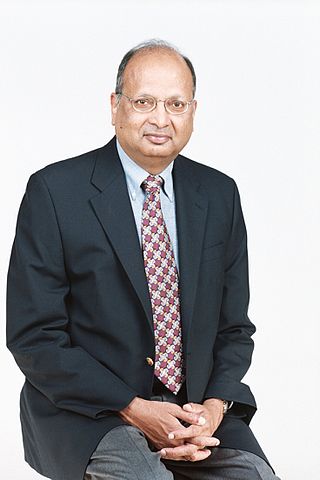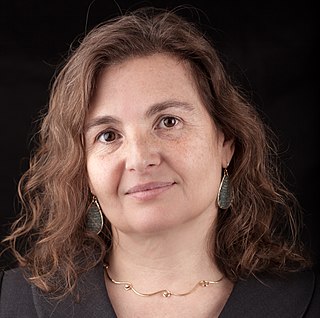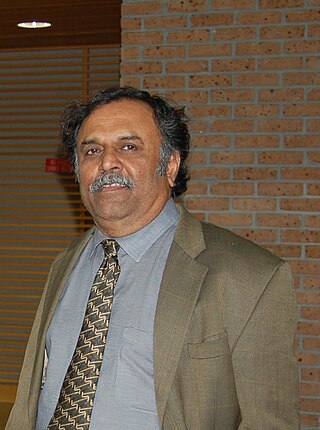Related Research Articles
Smartdust is a system of many tiny microelectromechanical systems (MEMS) such as sensors, robots, or other devices, that can detect, for example, light, temperature, vibration, magnetism, or chemicals. They are usually operated on a computer network wirelessly and are distributed over some area to perform tasks, usually sensing through radio-frequency identification. Without an antenna of much greater size the range of tiny smart dust communication devices is measured in a few millimeters and they may be vulnerable to electromagnetic disablement and destruction by microwave exposure.

iRobot Corporation is an American technology company that designs and builds consumer robots. It was founded in 1990 by three members of MIT's Artificial Intelligence Lab, who designed robots for space exploration and military defense. The company's products include a range of autonomous home vacuum cleaners (Roomba), floor moppers, and other autonomous cleaning devices.

An underwater glider is a type of autonomous underwater vehicle (AUV) that employs variable-buoyancy propulsion instead of traditional propellers or thrusters. It employs variable buoyancy in a similar way to a profiling float, but unlike a float, which can move only up and down, an underwater glider is fitted with hydrofoils that allow it to glide forward while descending through the water. At a certain depth, the glider switches to positive buoyancy to climb back up and forward, and the cycle is then repeated.

Rosalind Wright Picard is an American scholar and inventor who is Professor of Media Arts and Sciences at MIT, founder and director of the Affective Computing Research Group at the MIT Media Lab, and co-founder of the startups Affectiva and Empatica.

Marc Raibert is the Executive Director of the Boston Dynamics AI Institute, a Hyundai Motor Group organization that is focused on solving the most important problems in robotics and artificial intelligence to achieve fundamental advances in the engineering and science of robotics. Raibert was the founder, former CEO, and now Chairman of Boston Dynamics, a robotics company known for creating BigDog, Atlas, Spot, and Handle.

Linda G. Shapiro is a professor in the Department of Computer Science and Engineering, a professor of electrical engineering, and adjunct professor of Biomedical Informatics and Medical Education at the University of Washington.

Arogyaswami J. Paulraj is an Indian-American electrical engineer, academic. He is a Professor Emeritus in the Dept. of Elect. Engg. at Stanford University.
Cyber-Physical System (CPS) are integrations of computation with physical processes. In cyber-physical systems, physical and software components are deeply intertwined, able to operate on different spatial and temporal scales, exhibit multiple and distinct behavioral modalities, and interact with each other in ways that change with context. CPS involves transdisciplinary approaches, merging theory of cybernetics, mechatronics, design and process science. The process control is often referred to as embedded systems. In embedded systems, the emphasis tends to be more on the computational elements, and less on an intense link between the computational and physical elements. CPS is also similar to the Internet of Things (IoT), sharing the same basic architecture; nevertheless, CPS presents a higher combination and coordination between physical and computational elements.

Daniela L. Rus is a roboticist and computer scientist, Director of the MIT Computer Science and Artificial Intelligence Laboratory (CSAIL), and the Andrew and Erna Viterbi Professor in the Department of Electrical Engineering and Computer Science (EECS) at the Massachusetts Institute of Technology. She is the author of the books Computing the Future and The Heart and the Chip.
David Ethan Culler is a computer scientist and former chair of the Department of Electrical Engineering and Computer Sciences at the University of California, Berkeley. He is a principal investigator in the Software Defined Buildings (SDB) project at the EECS Department at Berkeley and the faculty director of the i4Energy Center. His research addresses networks of small, embedded wireless devices, planetary-scale internet services, parallel computer architecture, parallel programming languages, and high performance communication. This includes TinyOS, Berkeley Motes, PlanetLab, Networks of Workstations (NOW), Internet services, Active Message, Split-C, and the Threaded Abstract Machine (TAM).

Sundaraja Sitharama Iyengar is an Indian-born American computer scientist and the Distinguished University Professor, Ryder Professor and Director of Computer Science at Florida International University, Miami, Florida, USA. He also founded and directs the Robotics Research Laboratory at Louisiana State University (LSU). He has been a visiting professor or scientist at Oak Ridge National Laboratory, Jet Propulsion Laboratory, Naval Research Laboratory, and has been awarded the Satish Dhawan Visiting Chaired Professorship at the Indian Institute of Science, the Homi Bhaba Visiting Chaired Professor (IGCAR), and a professorship at the University of Paris (Sorbonne).
Ambient backscatter uses existing radio frequency signals, such as radio, television and mobile telephony, to transmit data without a battery or power grid connection. Each such device uses an antenna to pick up an existing signal and convert it into tens to hundreds of microwatts of electricity. It uses that power to modify and reflect the signal with encoded data. Antennas on other devices, in turn, detect that signal and can respond accordingly.
Peter Corke is an Australian roboticist known for his work on Visual Servoing, field robotics, online education, the online Robot Academy and the Robotics Toolbox and Machine Vision Toolbox for MATLAB. He is currently director of the Australian Research Council Centre of Excellence for Robotic Vision, and a Distinguished Professor of Robotic Vision at Queensland University of Technology. His research is concerned with robotic vision, flying robots and farming robots.
Dharma P. Agrawal was a communications scientist who specialised in wireless sensor networks. Since 1998 he has been the Ohio Board of Regents Distinguished Professor of Electrical Engineering and Computing Systems at the University of Cincinnati. He has published work on wireless sensor networks and ad-hoc computing, and was one of the editors of the Encyclopedia on Ad Hoc and Ubiquitous Computing in 2009.
Stefano Soatto is professor of computer science at the University of California, Los Angeles (UCLA), in Los Angeles, CA, where he is also professor of electrical engineering and founding director of the UCLA Vision Lab.
Mahta Moghaddam is an Iranian-American electrical and computer engineer and William M. Hogue Professor of Electrical Engineering in the Ming Hsieh Department of Electrical and Computer Engineering at the University of Southern California Viterbi School of Engineering. Moghaddam is also the president of the IEEE Antennas and Propagation Society and is known for developing sensor systems and algorithms for high-resolution characterization of the environment to quantify the effects of climate change. She also has developed innovative tools using microwave technology to visualize biological structures and target them in real-time with high-power focused microwave ablation.
J. J. Garcia-Luna-Aceves is a Mexican-American computer engineer, currently professor at the University of Toronto's Department of Electrical and Computer Engineering. Until 2023, he was the Distinguished Professor of Computer Science and Engineering at University of California at Santa Cruz UCSC, holding the Jack Baskin Endowed Chair of Computer Engineering, is CITRIS Campus Director for UCSC, and was a Principal Scientist at the Xerox Palo Alto Research Center. He is a Fellow of the IEEE for contributions to theory and design of communication protocols for network routing and channel access and a fellow to AAAS.
Diane Joyce Cook is an American computer scientist whose research interests include artificial intelligence, data mining, machine learning, home automation, and smart environments. She is Regents Professor and Huie-Rogers Chair Professor of Electrical Engineering and Computer Science at Washington State University.
Akira Ishimaru is a Japanese-American electrical engineer and professor emeritus at Department of Electrical and Computer Engineering at University of Washington. He is best known for his contributions to the theory of wave scattering in random media.
Yingying (Jennifer) Chen is a computer scientist whose research involves mobile computing, the internet of things, the security implications of mobile sensor data, wearable technology, and activity trackers. She is a professor at Rutgers University, where she heads the Department of Electrical and Computer Engineering and directs the Data Analysis and Information SecuritY (DAISY) Lab.
References
- ↑ Markoff, John (2008-08-21). "Intel pursues technology for recharging without wires" . The New York Times . ISSN 0362-4331 . Retrieved 2022-05-21.
- ↑ Lohr, Steve (January 30, 2010). "Smart Dust? Not Quite, but We're Getting There" . The New York Times. ISSN 0362-4331 . Retrieved 2022-05-21.
- ↑ Mims, Christopher (November 8, 2018). "Here Comes 'Smart Dust,' the Tiny Computers That Pull Power from the Air" . The Wall Street Journal . ISSN 0099-9660 . Retrieved 2022-05-21.
- ↑ Mims, Christopher (October 3, 2020). "Battery-Free, Energy-Harvesting Perpetual Machines: The Weird Future of Computing" . Wall Street Journal. ISSN 0099-9660 . Retrieved 2022-05-21.
- ↑ "Joshua R. Smith, PhD". sensor.cs.washington.edu. Retrieved 2022-05-14.
- 1 2 "Professor Joshua R. Smith Honored as IEEE Fellow". University of Washington Department of Electrical & Computer Engineering. December 13, 2019.
- ↑ "Sensor Systems Lab Research". sensor.cs.washington.edu. Retrieved 2022-05-14.
- ↑ "New 'Science Hub' to launch at Univ. of Washington with $1.9M from Amazon". GeekWire. February 9, 2022. Retrieved 2022-05-21.
- ↑ "New UW-Amazon Science Hub launches". Amazon Science. 2022-02-09. Retrieved 2022-05-14.
- 1 2 3 4 "IEEE Fellows Directory: Joshua Smith". www.ieee.org. Retrieved 2022-05-14.
- ↑ "Allen School News » Allen School faculty and alumni honored by ACM and IEEE for advancing the field of computing through research and service" . Retrieved 2022-05-14.
- ↑ "Congratulations 2021 Class of Fellows" (PDF). National Academy of Inventors . Retrieved 2022-05-14.
- 1 2 3 "UW professor Joshua R. Smith elected Fellow of the National Academy of Inventors for his innovations in wireless power, communication, sensing and robotics" . Retrieved 2022-05-14.
- ↑ "Allen Distinguished Investigators". Allen Institute. Retrieved 2022-05-14.
- ↑ "Coiled and ready to strike". The Economist . ISSN 0013-0613 . Retrieved 2022-05-21.
- ↑ Long, Katherine Anne (November 22, 2020). "Seattle startup WiBotic joins NASA-funded team to help moon robots survive the long lunar night". The Seattle Times . Retrieved 2022-07-15.
- ↑ "PROPRIO, INC. :: Washington (US) :: OpenCorporates". opencorporates.com. Retrieved 2022-05-21.